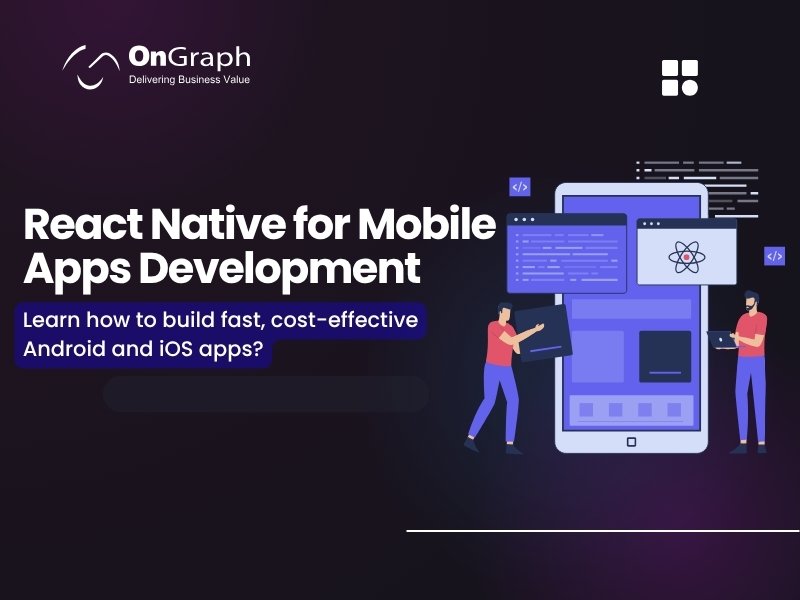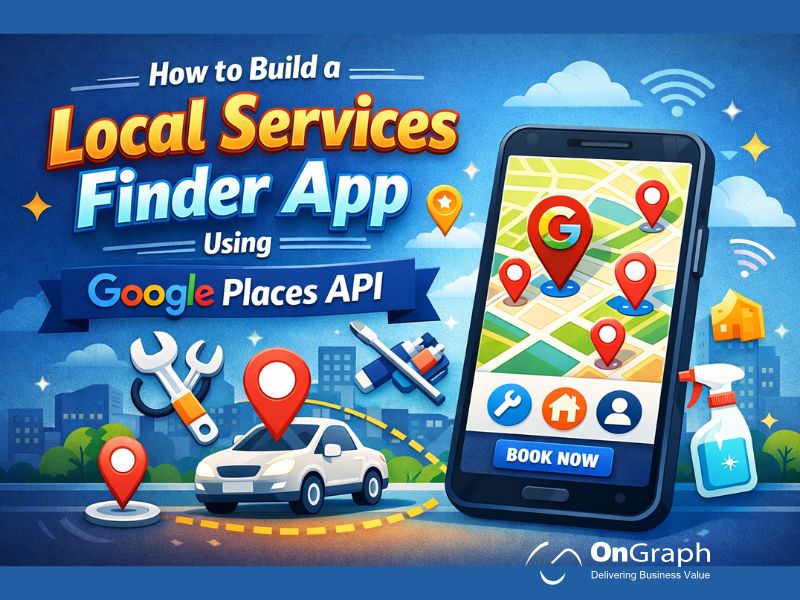In this article
- Why Choose React Native for Mobile App Development?
- Key Features of the React Native Framework
- React Native for Android and iOS
- Real-World Example: Instagram’s Journey with React Native
- Case Study: eCommerce Brand Saved 40% Cost Using React Native
- Build a React Native App in 5 Simple Steps
- React Native Web App: One Codebase for Web Too?
- React Native vs Native App Development: What’s Better?
- When to Hire a React Native Developer?
- Final Thoughts
When businesses think of building apps that work smoothly on both iOS and Android, React Native for mobile app development often tops the list. Launched by Facebook in 2015, this open-source framework allows developers to use a single codebase to create apps for multiple platforms.
In 2025, React Native continues to be a strong choice for startups, enterprises, and product teams looking to launch fast, scale quickly, and save costs.
Why Choose React Native for Mobile App Development?
React Native is built on JavaScript and allows developers to build mobile apps using React—a powerful frontend library. Instead of building separate apps for iOS and Android, you write once and run anywhere.
Benefits of React Native Application Development:
1- Faster Time to Market
Build apps faster with shared code across platforms.
2- Cost-Efficient
One team, one codebase = reduced development costs.
3- Large Community & Support
Thousands of developers and React Native libraries make problem-solving easier.
4- Live & Hot Reloading
See code changes instantly without rebuilding the app.
5- Near-Native Performance
Apps built using React Native perform very close to native apps in terms of speed and responsiveness.
Key Features of the React Native Framework
- Component-Based Architecture
Reusable components make app development modular and efficient. - Native Modules
Easily integrate native features using Java, Swift, or Objective-C when needed. - Rich Third-Party Plugin Support
Use libraries for maps, camera, payments, and more without starting from scratch. - Strong Compatibility
React Native works well with other React Frameworks and tools.
Build a Blazing-Fast React Native App
React Native for Android and iOS
React Native supports both iOS and Android development. Whether you’re building an app for the Play Store or App Store, React Native ensures a consistent look and feel.
- React Native for Android is ideal for businesses targeting India’s 80% Android user base.
- iOS apps built with React Native are just as performant and smooth.
By maintaining one codebase, you reduce bugs, development time, and maintenance efforts.
Real-World Example: Instagram’s Journey with React Native
Did you know Instagram uses React Native?
Instagram started migrating parts of its app to React Native in 2016. One of the first features to be rebuilt was the Push Notification view. It took less time than expected and reused 85–99% of code across iOS and Android. This helped Instagram ship updates faster with fewer bugs.
That’s the power of React Native mobile app development.
Case Study: eCommerce Brand Saved 40% Cost Using React Native
Client: A mid-sized US-based D2C clothing brand
Need: Build a mobile app with cart, payments, loyalty points
Challenge: Limited budget and tight deadline (60 days)
Solution:
- The client hired a React Native App Development Company
- We used pre-built libraries for cart, Stripe for payments, and Firebase for login/authentication
- Delivered both iOS and Android apps in 55 days
Results:
- Saved 40% on development cost vs. native app
- Launched MVP 3 weeks ahead of time
- App maintained 4.6-star rating across platforms
Build a React Native App in 5 Simple Steps
1- Define Your App Scope – List features like login, search, payments, push notifications.
2- Choose the Right Stack – Use Redux, Firebase, React Navigation, etc.
3- Hire React Native Developers – Look for experienced engineers or a trusted agency.
4- Test Across Devices – Make sure your app looks good on both Android and iOS.
5- Publish and Monitor – Launch to app stores and track performance via analytics.
React Native Web App: One Codebase for Web Too?
Yes, you can use React Native for Web to build a web app with the same codebase. For businesses looking to build a mobile + web experience together, React Native saves time and effort.
However, depending on UI complexity, you may need to customize some views separately for the web.
React Native vs Native App Development: What’s Better?
| Criteria | React Native | Native (Java/Kotlin/Swift) |
| Speed to Develop | Faster (Single Codebase) | Slower (Separate Codebases) |
| Performance | Good (90-95% of native) | Excellent |
| Cost | Lower | Higher |
| Maintenance | Easier | Complex |
| Access to Native APIs | Possible (via bridges) | Direct |
Verdict: Choose React Native if:
- You want to launch on both platforms
- You have budget or time limitations
- You want faster updates
Choose Native if:
- You need advanced animations, AR, or hardware integrations
- You’re building performance-critical apps like games
When to Hire a React Native Developer?
You should hire React Native developers when:
- You want to build an MVP in 30–60 days
- You need to scale quickly without growing your dev team
- You’re migrating a web app to mobile using the React Native framework
Ensure your developers are experienced with:
- Redux, REST APIs
- Performance optimization
- Platform-specific tweaks (like Android BackHandler or iOS gestures)
You can also partner with a reliable React Native App Development Company for end-to-end delivery.
React Native = Speed + Savings. Estimate Now!
Final Thoughts
React Native is no longer “new.” It’s a proven, mature technology used by top brands like Facebook, Uber, Bloomberg, Walmart, and more. Whether you want to build a cross-platform app fast, save cost, or maintain a single codebase, React Native for mobile app development is the way to go in 2025.
FAQs
React Native is a cross-platform framework developed by Facebook that allows developers to build mobile apps using JavaScript and React. It lets you use one codebase for both Android and iOS, reducing development time and cost. Instead of writing separate apps in Swift (iOS) and Kotlin (Android), React Native enables developers to write code once and deploy it across platforms, maintaining native-like performance and UI.
Yes, React Native is an excellent choice in 2025 for both Android and iOS. It is trusted by top companies like Instagram, Shopify, and Tesla. With regular updates and a strong community, React Native has become more stable and powerful. For Android specifically, it handles system APIs and native modules smoothly. For iOS, performance has improved with the integration of Hermes engine and advanced rendering strategies.
On average, a React Native app can cost between $10,000 to $60,000+ depending on features, complexity, and location of the development team. Since it allows using one team and one codebase, the overall development cost can be 40–50% lower compared to building two native apps separately. MVPs and early-stage apps can often be developed faster and cheaper using React Native.
- Faster Development: Code once, deploy everywhere
- Lower Costs: One team for both iOS and Android
- Live Reloading: Faster debugging and iteration
- Third-Party Plugins: Easily add maps, payments, and camera features
- Community Support: Thousands of open-source libraries and contributors
Yes, with React Native Web, you can extend your mobile app to run in browsers using the same React Native components. While you may need to make minor adjustments for responsiveness or layout, you still benefit from a unified codebase and easier maintenance.
Absolutely. With proper architecture (e.g., Redux, modular folders, lazy loading), React Native scales well. Many large apps—like Discord, Microsoft Office Mobile, and Shopify—use it successfully. For enterprise apps requiring security and performance, native modules can be integrated when needed without rewriting the whole app.
If you’re building a simple app or MVP, a freelance React Native developer can be cost-effective. For complex projects, a full React Native App Development Company is better as it offers a complete team (PM, testers, designers). Agencies also provide structured project management, ongoing support, and faster turnaround time with accountability.
About the Author
Let’s Create Something Great Together!
Latest Blog
















